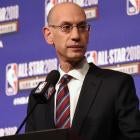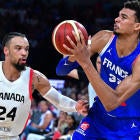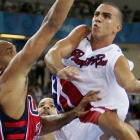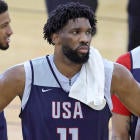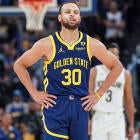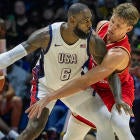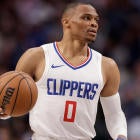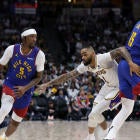The U.S. economy is currently grappling with millions of people unable to work in the wake of the coronavirus pandemic. The billionaires and millionaires that populate the NBA are going to be just fine. Mildly inconvenienced, maybe, but fine. They are going to lose money, though. Quite a bit of it, barring a miracle, and that lost money is going to drastically alter the product we see on the floor when those billionaires and millionaires ultimately do bring back their basketball league. Teams spend years carefully balancing their cap sheets in order to make the moves necessary to vault themselves into championship contention, but nobody is quite certain what those cap sheets will look like now that the 2019-20 season is suspended.
So let's attempt to figure it out. While real dollar figures are unknowable at this point, we can at least look at the problems facing the league financially and how it could overcome them in order to return to something close to the status quo.
How does the cap work in a normal year?
The collective bargaining agreement guarantees players a certain percentage of the league's basketball-related income (BRI) every year. That can range from 49-51 percent based on a variety of factors, and most of that figure goes into the cap. Before every season, the league projects how much BRI it expects to generate. It then takes 44.74 percent of that figure, subtracts the cost of benefits, divides that total by 30 teams, and that creates the cap.
So if players are guaranteed between 49-51 percent of BRI, why only use 44.74 percent in cap calculations? Because the NBA's cap is soft. Teams are allowed to go over it through a variety of exceptions, and practically every team does. If they go too far over it and the players make more than 51 percent of BRI, that overage is subtracted from the next season's cap. If teams don't reach 49 percent, that shortfall is added to the next season's cap.
It is a system that is meant to be simple, repeatable and projectible. Under normal circumstances, teams reasonably know what to expect from the cap for at least the next two or three seasons. The circumstances facing the league right now, though, are anything but normal.
How does this stoppage impact the league's finances?
Even the NBA's current best-case scenario of a June return would be catastrophic for the league's finances. Games played without fans in the stands would cost the league a fortune not only in ticket sales, but in food, beverage, parking and merchandise sales. Television ratings might soar in a socially-distanced society, but with rights locked up years in advance, the NBA itself wouldn't reap the benefits. Its partners at ESPN and Turner would. If games are called off entirely? That's money that the league has to return.
Just how much money the league stands to lose isn't fully clear yet. It depends on how many games are lost, the wording of their contracts with broadcasting and advertising partners and the effect this pandemic has on the economy as a whole. As the cap is currently structured, though, it is the owners who are set to take the hit far more than the players.
There are two important reasons why. The first is that most player contracts are signed years in advance and paid out primarily over the course of the regular season (though exact pay schedules are spelled out in individual contracts), which was almost complete before the stoppage began. Players can sign deals up to five years long. Raises are usually built into those contracts because revenue usually rises. Even if it doesn't, those contracts aren't affected. Exact dollar figures are spelled out in NBA contracts rather than ranges or percentages of the cap.
The same can't be said for the cap itself, though, which is based on a projection. Let's say that this season is canceled, but next season projects to start on time. Projected revenue would then be largely unaffected, setting the cap at its expected rate, but forcing the owners to eat all of the losses from this season.
Let's make this clear, the owners absolutely are not sustaining that loss on their own. The CBA gives them a number of methods of sharing the burden with players. The CBA has a force majeure clause, for example, that allows the league to terminate the agreement entirely in situations like this. In addition, 10 percent of all player salaries are held in escrow in case total player salaries leaguewide exceed 51 percent of revenue. In a year like this, in which salaries were guaranteed in advance but revenue is lost, there is no question that salaries will exceed 51 percent of the revenue that this season generated.
So, the players could fight protracted legal battles with the NBA over every last dime, or the two sides can come to an agreement that spreads the burden more evenly. Fortunately, the latter seems likely given the strong working relationship the two sides have had over the past decade, particularly since Adam Silver took over as commissioner. Money is going to be lost on both sides, but there are ways to maintain something resembling normalcy from a cap perspective.
What are some possible solutions to these issues?
Get ready for months and months of "cap smoothing" talk. The principle was first presented in 2016, when a lucrative new national television deal created an unheard of spike in the cap. In a single summer, the cap jumped 32 percent, giving almost every team in the NBA cap space at the same time, enabling, among other things, Kevin Durant joining the Golden State Warriors and backups like Timofey Mozgov and Ian Mahinmi earning contracts that crippled their teams for years.
The league tried to prevent both outcomes by offering smoothing. Rather than integrating all of the new money into the cap at once, the cap would rise gradually over the course of several years. Players would still make all of their money, it just wouldn't happen immediately. The union rejected that proposal. It likely regrets doing so. While a few players like Mozgov and Mahinmi hit the jackpot, the majority of its membership suffered due to the frugality that followed those deals. No team wanted to sign the next Mozgov. Few teams even had the cap space to try. Durant joining the Warriors removed much of the drama from the next several seasons.
The same idea could be applied in reverse here. Rather than drastically lowering the cap all at once, the NBA could build the losses from this season into the cap for the next several years. In some form or another, this is probably what ends up happening. After all, rejecting smoothing would largely be pointless. Considering the money already guaranteed to players, a drastically lowered cap would just end with players making significantly more than 51 percent of BRI. That money would then be funneled back to the owners in the form of a lowered cap a year later, essentially creating smoothing. At least if the union agrees, they can dictate more preferable terms.
That doesn't make smoothing a perfect solution. While few teams will shed tears over last cap space in 2020's weak free-agent class, a number of teams have spent years planning for a 2021 bonanza. Giannis Antetokounmpo is expected to lead one of the greatest free-agent classes ever. Some of the teams expected to pursue him have the flexibility to do so either way. Others, notably the Dallas Mavericks, were cutting it close before this crisis. A lower cap would mean making moves to generate the space.
A way to satisfy teams with specific plans for their cap space over the next several years might be the institution of another amnesty clause. Previous CBAs have given teams the right to waive one player and fully remove his salary from their cap sheet while still actually paying him. Doing so again would obviously increase the players' percentage of revenue, but it would allow teams more control over managing its finances in the wake of an unexpected tragedy. It's not a perfect measure, but given the circumstances, one doesn't exist. The league is scrambling to make the best of a bad situation, and sadly, there is no outcome that doesn't greatly affect several parties.
Who does a lowered cap really impact?
No matter how you slice it, there are players and teams that are going to be hurt by this lost revenue. The most obvious group is 2020 free agents. As it stood before the stoppage, only six teams figured to have meaningful cap space this summer: The Hawks, Knicks, Pistons, Hornets, Suns and Heat. Five of those teams are rebuilding. Veterans looking to cash in were going to have a hard time this summer to begin with. Now, if some of the very limited cap space is off of the table? Things will be even harder. Expect almost any player with an option for next season to pick it up and try his luck in 2021.
The other camp largely impacted by a potential cap drop are the teams that had no intention of using cap space at all. The luxury tax line is based on the cap. If the cap is drastically lowered, the tax line will be as well. That is a problem for teams that already have most of their expected salary committed for next season. Houston, for example, signed Eric Gordon to a four-year, $76 million extension before this season expecting the cap and tax to rise. If they fall, Houston is suddenly in cap hell with Gordon, Russell Westbrook and James Harden alone combining to make nearly $100 million next season. The Rockets have taken drastic steps to avoid the tax in the past. Doing so next season if the line falls enough would be impossible.
Another team that has surrendered assets to avoid the tax is the Denver Nuggets. They wouldn't be locked into paying it next season as Houston would be, but on the court, that would be to their detriment. Denver has four key free agents this offseason: Paul Millsap, Jerami Grant, Mason Plumlee and Torrey Craig. They were destined to jettison one or two of them even before all of this happened. Now, with $98 million already committed (or $107 million if Grant opts into the final year of his deal), losing three or potentially four is in play.
With that in mind, don't be surprised if the league considers lifting the luxury tax for a year. Doing so would be a competitive measure as much as a financial one. The Lakers can afford to pay the tax every year if the need arises. The Nuggets and Rockets can't. The tax was never built to cripple smaller markets in the aftermath of a national crisis. It will likely have to be altered in some way to accommodate teams dealing with this pandemic.
That is, of course, speculative. At the moment, all of this is speculation. It will take months or perhaps years for the NBA to truly sort through the wreckage of this season and return to some semblance of financial normalcy. All of those plans your team has spent years crafting have now flown out the window. Almost everything is in play from this point forward.









